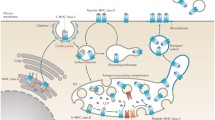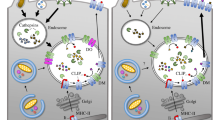Abstract
Major histocompatibility (MHC) class II molecules present peptides derived from exogenous antigens to CD4+ T lymphocytes (reviewed 1,2,3). The MHC class II molecule is a heterodimer of two transmembrane subunits, an α chain (33 kDa) and β chain (29 kDa), both encoded in the MHC region4. The ends of the peptide-binding groove of MHC class II molecules are open so peptides can extend out. As a result, MHC class II-associated peptides have a length varying between 12–24 amino acids residues5. MHC class II molecules are primarily expressed on antigen presenting cells (APC), such as B cells, macrophages and dendritic cells (DC).
Access this chapter
Tax calculation will be finalised at checkout
Purchases are for personal use only
Preview
Unable to display preview. Download preview PDF.
Similar content being viewed by others
References
P. Cresswell, Assembly, transport, and function of MHC class II molecules, Annu. Rev. Immunol. 12:259 (1994).
R.N. Germain, MHC-dependent antigen processing and peptide presentation: providing ligands for T lymphocyte activation, Cell 76:287 (1994).
J.J. Neefjes and F. Momburg, Cell biology of antigen presentation, Curr. Opin. Immunol. 5:27 (1993).
J.J. Monaco, Structure and function of genes in the MHC class II region, Curr. Opin. Immunol. 5:17 (1993).
H.-G. Rammensee, K. Falk and O. Rötschke, MHC molecules as peptide receptors, Curr. Opin. Immunol.5:35 (1993).
C. V. Harding and H.J. Geuze, Antigen processing and intracellular traffic of antigens and MHC molecules,Curr. Opin. Cell. Biol. 5:596 (1993).
M.J. Kleijmeer, M.A. Ossevoort, C.J.H. Van Veen, J.J. Van Hellemond, J.J. Neefjes, W.M. Kast, W.M.,C.J.M. Melief and H.J. Geuze, MHC class II compartments and the kinetics of antigen presentation in activated dendritic cells, submitted (1994).
H.W. Nijman, M.J. Kleijmeer, M.A. Ossevoort, V.M.J. Oorschot, M.P.M. Vierboom, P. Kenemans, W.M.Kast, H.J. Geuze and C.J.M. Melief, Freshly isolated and cultured human dendritic cells show the immature and mature phenotypes respectively, submitted (1994).
C.J.M. Melief, Dendritic cells as specialized antigen presenting cells, Res. Immunol. 140:902 (1989).
R.M. Steinman, The dendritic cell system and its role in immunogenicity, Annu. Rev. Immunol. 9:27 (1991).
C.A. Lamb, J.W. Yewdell, J.R. Bennink and P. Cresswell, Invariant chain targets HLA class II molecules to acidic endosomes containing internalized influenza virus, Proc. Natl. Acad. Sci. USA 88:5998 (1991).
P. Romagnoli, C. Layet, J. Yewdell, O. Bakke and R.N. Germain, Relationship between invariant chain expression and major histocompatibility complex class II transport into early and late endocytic compartments, J. Exp. Med. 177:583 (1993).
P.J. Peters, J.J. Neefjes, V. Oorschot, H.L. Ploegh and H.J. Geuze, Segregation of MHC class II molecules from MHC class I molecules in the golgi complex for transport to lysosomal compartments, Nature 349:669 (1991).
C.V. Harding and H.J. Geuze, Immunogenic peptides bind to class II MHC molecules in an early lysosomal compartment, J. Immunol. 151:3988 (1993).
Y. Qui, X. Xu, A. Wandinger-Ness, D.P. Dalke, and S.K. Pierce, Separation of subcellular compartments containing distinct functional forms of MHC class II, J. Cell Biol. 125:595 (1994).
A. Tulp, D. Verwoerd, B. Dobberstein, H.L. Ploegh and J. Pieters, Isolation and characterization of the intracellular MHC class II compartment, Nature 369:120 (1994).
J.M. Riberdy, R.R. Avva, H.J. Geuze and P. Cresswell, Transport and intracellular distribution of MHC class II molecules and associated invariant chain in normal and antigen-processing mutant cell lines, 1994,7. Cell Biol. 125:1225(1994).
M.A. West, J.M. Lucocq and C. Watts, Antigen processing and class II MHC peptide-loading compart ments in human B-lymphoblastoid cells, Nature 369:147 (1994).
R.N. Germain and L.R. Hendrix, MHC class II structure, occupancy and surface expression determined by post-endoplasmic reticulum antigen binding, Nature 353:134 (1991).
S. Amigorena, J.R. Drake, P. Webster and I. Mellman, Transient accumulation of new class II MHC molecules in a novel endocytic compartment in B lymphocytes, Nature 369:113 (1994).
P.A. Roche, C.L. Teletski, E. Stang, O. Bakke and E.O. Long, Cell surface HLA-DR-invariant chain complexes are targeted to endosomes by rapid internalization, Proc. Natl. Acad. Sci. USA 90:8581 (1993).
R.M. Steinman, G. Kaplan, M.D. Witman and Z.A. Cohn, Identification of a novel cell-type in peripheral lymphoid organs of mice. V. purification of spleen dendritic cells, new surface markers, and maintenance in vitro, J. Exp. Med. 149:1 (1979).
T.P. Levine and B.M. Chain, Endocytotic activity of dendritic cells is similar to other antigen presenting cells, in:Dendritic Cells in Fundamental and Clinical Immunology”, Kamperdijk, E.W.A., Nieuwenhuis, P., Hoefsmit, E.L.M. eds., Plenum Press, New York (1993).
M.L.H. De Bruijn, J.D. Nieland, C.V. Harding and C.J.M. Melief, Processing and presentation of intact henn egg-white lysozyme by dendritic cells, Eur. J. immunol. 22:2347 (1992).
Author information
Authors and Affiliations
Editor information
Editors and Affiliations
Rights and permissions
Copyright information
© 1995 Springer Science+Business Media New York
About this chapter
Cite this chapter
Ossevoort, M.A., Kleijmeer, M.J., Nijman, H.W., Geuze, H.J., Kast, W.M., Melief, C.J.M. (1995). Functional and Ultrastructural Aspects of Antigen Processing by Dendritic Cells. In: Banchereau, J., Schmitt, D. (eds) Dendritic Cells in Fundamental and Clinical Immunology. Advances in Experimental Medicine and Biology, vol 378. Springer, Boston, MA. https://doi.org/10.1007/978-1-4615-1971-3_51
Download citation
DOI: https://doi.org/10.1007/978-1-4615-1971-3_51
Publisher Name: Springer, Boston, MA
Print ISBN: 978-1-4613-5811-4
Online ISBN: 978-1-4615-1971-3
eBook Packages: Springer Book Archive




